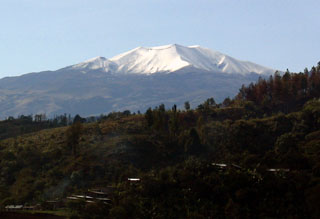Report on Purace (Colombia) — 6 April-12 April 2022
Smithsonian Institution / US Geological Survey
Weekly Volcanic Activity Report, 6 April-12 April 2022
Managing Editor: Sally Sennert.
Please cite this report as:
Global Volcanism Program, 2022. Report on Purace (Colombia) (Sennert, S, ed.). Weekly Volcanic Activity Report, 6 April-12 April 2022. Smithsonian Institution and US Geological Survey.
Purace
Colombia
2.32°N, 76.4°W; summit elev. 4650 m
All times are local (unless otherwise noted)
On 29 March Observatorio Vulcanológico y Sismológico de Popayán, Servicio Geologico Colombiano (SGC), reported that the number of earthquakes at Puracé had increased during the previous few weeks, and were characterized by volcano-tectonic (VT) events, indicating rock fracturing, and long-period (LP) and volcanic tremor (TR) events, indicating fluid movement. The number of events notably increased on 28 March, with 479 VT, 183 (LP), and 119 (TR) events in total. The magnitudes of events abruptly increased the next day; the largest event was a M 3.3 recorded at 1214 on 29 March. Two fractures opened on 29 March, each about 40 m long, and produced gas emissions detected by satellite; ash was reported by observers in the area. The fractures were located along Coconucos Volcanic Chain, between Puracé Volcano and Curiquinga Volcano. The Alert Level was raised to Yellow (the second lowest on a four-color scale) on 30 March.
Seismicity continued to be elevated through 4 April. The earthquakes were low magnitude, and located about 800 m SE of Puracé and beneath Curiquinga, at depths of 2 km on average. The number of events signifying fluid movement was increasing. GNSS (Global Navigation Satellite System) geodetic network and DInSAR (Differential Interferometry by Synthetic Aperture Radar) showed inflation on the millimeter scale. Sulfur dioxide and carbon dioxide emissions increased, based on satellite and ground-based sampling data, and a fumarole on the N flank of Puracé intensified and produced a strong sulfur odor.
Significant unrest continued during 5-11 April. The seismic network recorded a total of 2,077 earthquakes, consisting of 248 VT events, 1,759 LP events, 37 low-energy TR events, and 31 hybrid events. Millimeter-scale inflation persisted, and sulfur dioxide emissions averaged 1,800 tonnes per day.
Geological Summary. Puracé in Colombia consists of an andesitic stratovolcano with a 500-m-wide summit crater constructed over a dacitic shield volcano. It lies at the NW end of a volcanic massif opposite Pan de Azúcar stratovolcano, 6 km SE. A NW-SE-trending group of seven cones and craters, Los Coconucos, lies between the two larger edifices. Frequent explosive eruptions in the 19th and 20th centuries have modified the morphology of the summit crater. The largest eruptions occurred in 1849, 1869, and 1885.

